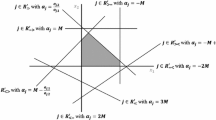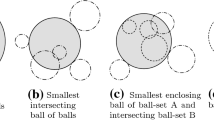Abstract
In this paper, a double-pivot simplex method is proposed. Two upper bounds of iteration numbers are derived. Applying one of the bounds to some special linear programming (LP) problems, such as LP with a totally unimodular matrix and Markov decision problem with a fixed discount rate, indicates that the double-pivot simplex method solves these problems in a strongly polynomial time. Applying the other bound to a variant of Klee–Minty cube shows that this bound is actually attainable. Numerical test on three variants of Klee–Minty cubes is performed for the problems with sizes as big as 200 constraints and 400 variables. The test result shows that the proposed algorithm performs extremely good for all three variants. Dantzig’s simplex method cannot handle the Klee–Minty cube problems with 200 constraints because it needs about \(2^{200} \approx 10^{60}\) iterations. Numerical test is also performed for randomly generated problems for both the proposed and Dantzig’s simplex methods. This test shows that the proposed method is promising for large-size problems.



Similar content being viewed by others
Notes
For \(m=n/2\), the matrix \(\mathbf{M} \) has \(\frac{n^2}{4}\) nonzeros, but for most Netlib problems, there are only \({\mathcal {O}}(n)\) nonzeros. Therefore, it is not a surprise that solving the randomly generated dense LP problems is time-consuming.
References
Avis, D., Chvàtal, V.: Notes on Bland’s pivoting rule. Math. Program. Study 8, 24–34 (1978)
Dantzig, G.B.: Programming in a linear structure. Econometrica 17, 73–74 (1949)
Dantzig, G.B.: Linear Programming and Extensions. Princeton University Press, Princeton (1963)
Friedmann, O.: A subexponential lower bound for Zadeh’s pivoting rule for solving linear programs and games. In: IPCO, pp. 192–206 (2011)
Gartner, B., Henk, M., Ziegler, G.M.: Randomized simplex algorithms on Klee–Minty cubes. Combinatorica 18(3), 49–372 (1998)
Goldfarb, D., Sit, W.Y.: Worst case behavior of the steepest edge simplex method. Discrete Appl. Math. 1, 277–285 (1979)
Greenberg, H.J.: Klee–Minty polytope shows exponential time complexity of simplex method. University of Colorado at Denver. https://glossary.informs.org/notes/Klee-Minty.pdf (1997). Accessed 3 Nov 2020
Ihrahima, F.: Degeneracy and geometry in the simplex method. Stanford University report, available from the Internet. https://cap.standford.edu/profiles/swmd?fid=48932&cwmld-3509 (2013). Accessed 3 Nov 2020
Jeroslow, R.G.: The simplex algorithm with the pivot rule of maximizing criterion improvement. Discrete Math. 4, 367–377 (1973)
Kalai, G., Kleitman, D.: A quasi-polynomial bound for the diameter of graphs of polyhedra. Bull. Am. Math. Soc. 26, 315–316 (1992)
Kelner, J.A., Spielman, D.A.: A randomized polynomial-time simplex algorithm for linear programming. In: Proceedings of the Thirty-Eighth Annual ACM Symposium on Theory of Computing, pp. 51–60 (2006)
Kitahara, T., Mizuno, S.: Klee–Minty’s LP and upper bounds for Dantzig’s simplex method. Oper. Res. Lett. 39(2), 88–91 (2011)
Kitahara, T., Mizuno, S.: A bound for the number of different basic solutions generated by the simplex method. Math. Program. 137, 579–586 (2013)
Kitahara, T., Mizuno, S.: An upper bound for the number of different solutions generated by the primal simplex method with any selection rule of entering variables. Asia Pac. J. Oper. Res. 30, 1340012 (2013)
Klee, V., Minty, G.J.: How good is the simplex algorithm? In: Shisha, O. (ed.) Inequalities, III, pp. 159–175. Academic Press, New York (1972)
Paparrizos, K., Samaras, N., Zissopoulos, D.: Linear programming: Klee–Minty examples. In: Floudas, C., Pardalos, P. (eds.) Encyclopedia of Optimization. Springer, Boston (2008)
Ploskas, N., Samaras, N.: Pivoting rules for the revised simplex algorithm. Yugosl. J. Oper. Res. 24(3), 321–332 (2014)
Santos, F.: A counterexample to the Hirsch conjecture. Ann. Math. 176, 383–412 (2012)
Santos, F.: The Hirsch conjecture has been disproved: an interview with Francisco Santos. EMS Newsletter, December 2012
Smale, S.: Mathematical problems for the next century. In: Arnold, V.I., Atiyah, M., Lax, P., Mazur, B. (eds.) Mathematics: Frontiers and Perspectives, pp. 271–294. American Mathematical Society, Providence (1999)
Sukegawa, N.: Improving bounds on the diameter of a polyhedron in high dimensions. Discrete Math. 340, 2134–2142 (2017)
Terlaky, T., Zhang, S.: Pivot rules for linear programming: a survey on recent theoretical developments. Ann. Oper. Res. 46(1), 203–233 (1993)
Todd, M.J.: An improved Kalai–Kleitman bound for the diameter of a polyhedron. SIAM J. Discrete Math. 26(2), 1944–1947 (2014)
Vitor, F.T.: Two dimensional search algorithms for linear programming. Doctoral dissertation. http://hdl.handle.net/2097/39723 (2019). Accessed 3 Nov 2020
Vitor, F.: The ratio algorithm to solve the optimal basis of two constraint linear programs. In: Barker, K., Berry, D., Rainwater, C. (eds.) Proceedings of the 2018 IISE Annual Conference, pp. 1949–1954. Institute of Industrial and Systems Engineers, Norcross (2018)
Vitor, F., Easton, T.: The double pivot simplex method. Math. Methods Oper. Res. 87(1), 109–137 (2018)
Yang, Y.: On the diameter of polytopes. arXiv:1809.06780v1 (2018)
Ye, Y.: The simplex and policy-iteration methods are strongly polynomial for the Markov decision problem with a fixed discount rate. Math. Oper. Res. 36(4), 593–603 (2011)
Acknowledgements
After this author finished the first version of this paper, he realized that Vitor and Easton [26] have recently proposed a similar idea to update two pivots at a time. This author would like to thank Dr. F. Vitor for sharing his paper which is very useful in comparing the proposed work to his excellent work. The author would also like to thank the anonymous reviewer for his constructive and detailed comments which lead to significant improvements of the paper.
Author information
Authors and Affiliations
Corresponding author
Additional information
Publisher's Note
Springer Nature remains neutral with regard to jurisdictional claims in published maps and institutional affiliations.
Rights and permissions
About this article
Cite this article
Yang, Y. A double-pivot simplex algorithm and its upper bounds of the iteration numbers. Res Math Sci 7, 34 (2020). https://doi.org/10.1007/s40687-020-00235-2
Received:
Accepted:
Published:
DOI: https://doi.org/10.1007/s40687-020-00235-2




